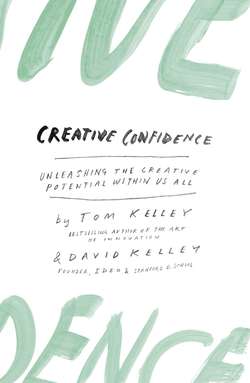Читать книгу Creative Confidence: Unleashing the Creative Potential Within Us All - David Kelley - Страница 20
CHAPTER 2 DARE FROM FEAR TO COURAGE
ОглавлениеPicture a boa constrictor, draped casually around a man’s neck. In the next room, a woman in a hockey mask and leather gloves stands warily behind a one-way mirror, watching them. Her heart is pounding. She has been terrified of snakes for as long as she can remember. Gardening and hiking have been out of the question, lest a garter snake slither across her path.
Yet here she is, about to walk into the next room and touch the snake of her nightmares.
How does she do it? How does she move from fear to courage?
The mastermind behind her phobia cure—leading the way for thousands more like her—is psychologist Albert Bandura. A Stanford researcher and professor, he has had a profound impact on the world of social learning and has been called the greatest living psychologist. Only Sigmund Freud, B. F. Skinner, and Jean Piaget ranked higher on a published list of eminent twentieth-century psychologists.
Bandura, now a professor emeritus at age eighty-seven, still works from his office at Stanford.
One day we got to talking about how to cure snake phobias. Basically it takes a lot of patience and small incremental steps, Bandura told us, but he and his colleagues could sometimes cure a phobia that has lasted a lifetime in less than a day.
First, Bandura tells phobic people that there is a snake in the room next door and that they are going in there—to which the typical response is “Like hell I am.”
Next, he leads them through a long sequence of challenges, tailoring each subsequent step to be just within reach. For example, at one point, he has them look through a one-way mirror at a man holding the snake and asks, “What do you think this thing will do?” People with phobias are convinced the snake will wrap itself around the man’s neck and choke him. But contrary to their beliefs, the snake just dangles lazily without choking or constricting at all.
And so it continues. Further along, Bandura asks them to stand at the open door of the room with the snake inside. If that step is too scary, he offers to stand with them at the door.
Many small steps later, eventually they are right there next to the snake. By the end of the session, people touch the snake. And just like that, their phobia is gone.
When Bandura began using this technique, he checked back with people months later and found that the phobia stayed gone, too. One woman even recounted a dream about a boa constrictor that helped her wash the dishes, instead of terrorizing her like the snakes in the nightmares she used to have.
Bandura calls the methodology he uses to cure phobias “guided mastery.”
The process of guided mastery draws on the power of firsthand experience to remove false beliefs. It incorporates psychology tools like vicarious learning, social persuasion, and graduated tasks. Along the way, it helps people confront a major fear and dispel it one small, manageable step at a time.
This discovery—that guided mastery can cure a lifelong phobia in a short time—was a big deal. But Bandura discovered something even more meaningful during his follow-up interviews with the former phobics.
The interviews brought to light some surprising side effects. People mentioned other changes in their lives, changes seemingly unrelated to their phobias: they’d taken up horseback riding, they’d become fearless public speakers, they were exploring new possibilities in their jobs. The dramatic experience of overcoming a phobia that had plagued them for decades—a phobia they had expected to live with for the rest of their lives—had altered their belief system about their own ability to change. It had altered their belief in what they could accomplish. Ultimately, it transformed their lives.
This newfound courage, exhibited by the same people who once had to wear hockey masks to get near a snake, led Bandura to pivot toward a new line of research: how people come to believe that they can change a situation and accomplish what they set out to do in the world.
Since then, Bandura’s research has shown that when people have this belief, they undertake tougher challenges, persevere longer, and are more resilient in the face of obstacles and failure. Bandura calls this belief “self-efficacy.”
Bandura’s work scientifically validates something we’ve been seeing for years: Doubts in one’s creative ability can be cured by guiding people through a series of small successes. And the experience can have a powerful effect on the rest of their lives.
The state of mind Bandura calls self-efficacy is closely related to what we think of as creative confidence.
People who have creative confidence make better choices, set off more easily in new directions, and are better able to find solutions to seemingly intractable problems. They see new possibilities and collaborate with others to improve the situations around them. And they approach challenges with newfound courage.
But to gain this creative, empowered mindset, sometimes you have to touch the snake.
In our experience, one of the scariest snakes in the room is the fear of failure, which manifests itself in such ways as fear of being judged, fear of getting started, fear of the unknown. And while much has been said about fear of failure, it still is the single biggest obstacle people face to creative success.
